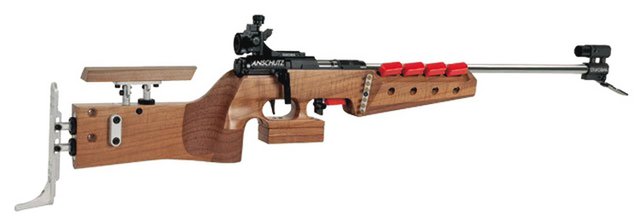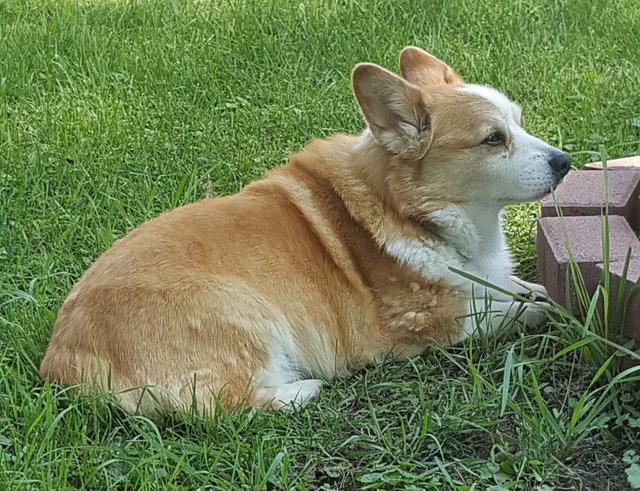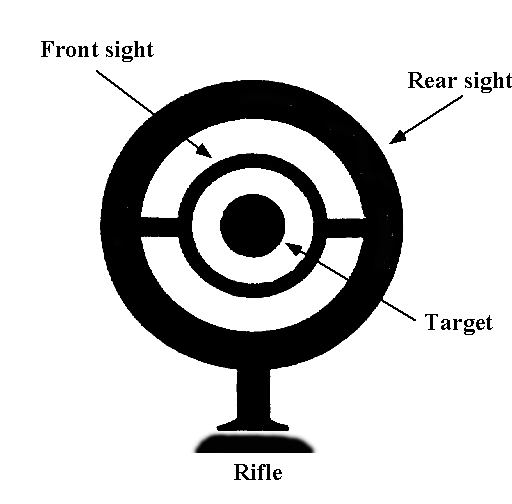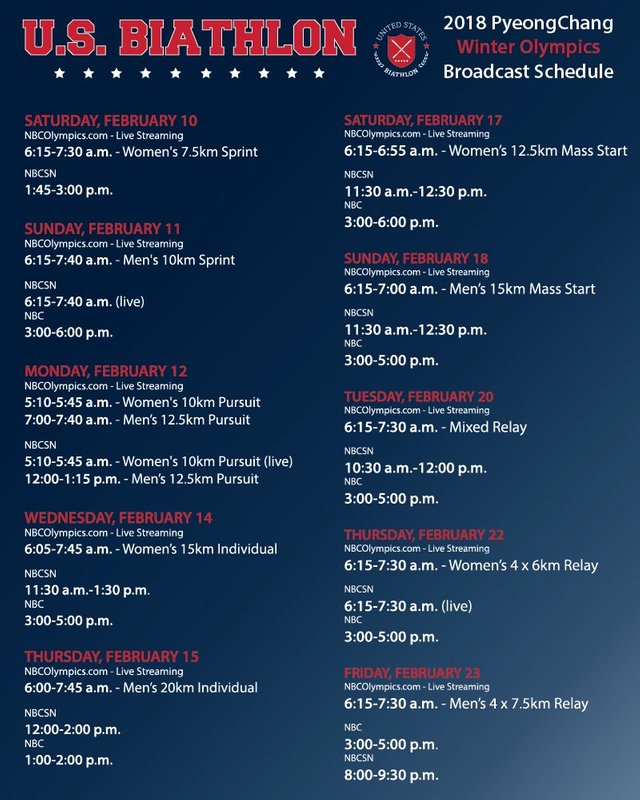Hi there. Let's talk about the biathlon, the only shooting sport to have a place in the Winter Olympics.
Really though, what the hell is a biathlon?
The biathlon event is the combination of cross country skiing and rifle marksmanship, and the name is derived from the event consisting of two different sports. Competitors, referred to as biathletes, race to designated firing lines where they must shoot five targets. This sequence is repeated a number of times, determined by the specific format, followed by a final lap to the finish line.
Alright, but why is this even an event?
Biathlon, as a shooting sport, began as a military exercise in Norway as early as the 1700s. Soldiers commonly travelled by ski and marksmanship training is of obvious importance to any combat unit, so combining the two into a single training exercise was an elegant solution. The Norwegian word for the event, skiskyting, translates literally into ski shooting.
It is difficult to overstate the importance of ski shooting in Scandinavian countries, particularly Finland. One of the defining moments of the Finnish military occurred during World War II when Finland, despite being vastly outnumbered, desperately under-supplied, and alone, managed to hold off an absolutely staggering Russian invasion force for over three months. Fifty thousand ski troopers with rifles managed to fight an army comprised of nearly half a million soldiers backed by tanks, artillery, and supply lines to a standstill in defense of their homeland. One of these ski troopers was a man named Simo Häyhä who, with over five hundred confirmed kills, is credited as the deadliest sniper in history and earned him the name "White Death" from the Soviet Army.
I strongly encourage you to read more about the Winter War, and Simo Häyhä, here:
History Channel: What was the Winter War?
History Channel: The World's Deadliest Sniper
So how did biathlon become an Olympic event?
The very first Winter Olympic Games, hosted by France in 1924, featured the military patrol as an official event, the precursor to the modern biathlon. The Winter Olympic Games of 1928, 1936, and 1948 featured the military patrol as a demonstration event.
The 1960 Winter Olympics, hosted by the United States at Squaw Valley, California, featured the very first official biathlon event. Due to the design and size of the venue and the expense of building the necessary accomodations, this was also the first, and so far only, Winter Olympics to not feature the bobsled event.
From 1960 and on, the biathlon has been present at every Winter Olympics. From 1960 to 1988, the event was restricted to men only and was finally opened to female competitors at the 1992 Winter Olympics, again hosted by France.
Okay, that sounds neat, so what are the rules?
It is neat, I'm glad you think so. There are five main variations of the biathlon, the individual, the sprint, the pursuit, the mass start, and the relay. All five disciplines are open to both men and women and there is also a mixed relay event that comprises of a team of two men and two women racing together under the relay format.
Individual biathlon consists of a 20km/12 mile race distance for men, 15km/9.3 miles for women, and four stops at a firing line. The marksmanship portion alternates between a prone position and a standing position, with two courses fired from each position, and requires the biathlete to hit five targets at each firing line for a total of twenty shots fired over the course of the race. Each missed target results in the biathlete receiving a one minute penalty applied to their completion time. Biathletes start the race in staggered intervals to avoid congestion on the track and at the firing line, and the winner is determined by their completion time.
Sprint reduces the race distance to 10km/6.2 miles for men and 7.5km/4.7 miles for women and includes only two firing lines, one shot from the prone position and one from the standing position, for a total of ten shots fired. In the sprint competition, instead of a standardized time penalty, missed targets require the biathlete to complete one 150 meter penalty lap per missed target. Elite-level athletes commonly complete the penalty lap in 20 to 30 seconds, depending on track conditions. Like the individual race, biathletes begin at staggered intervals and their completion times determine the final rankings.
Pursuit separates individuals by their finish times in a previous race, usually the sprint. As an example, let's say the second place finisher of the qualifying sprint race finished three seconds behind the first place finisher. During the pursuit race, the previous first place finisher would begin the race at the go signal and the previous second place finisher would be required to wait three seconds before beginning the pursuit race. Only the top 60 competitors from the sprint race qualify for the pursuit race. The pursuit race is over a 12.5km/7.8 mile distance for men and a 10km/6.2 mile distance for women, and has four courses of fire alternating between prone and standing firing positions. Missed targets result in a 150 meter penalty lap. The winner of the pursuit race is determined by crossing the finishing line, rather than by completion time.
Mass start is a 15km/9.3 mile men's race and a 12.5km/7.8 mile women's race, with four courses of fire alternating between prone and standing and misses resulting in a 150 meter penalty lap. Due to the athletes all beginning the race at the same time, the field of competitors is narrowed to 30, with three spots reserved for the medalists of the qualifying individual race and the remaining twenty seven chosen from the world ranking system developed and maintained by the International Biathlon Union. The winner is determined, as in the pursuit race, by crossing the finish line.
Relay races are a team competition. Teams consist of four biathletes, and each biathlete must complete their own individual 7.5km/4.7 mile leg for men or 6km/3.7 miles for women that also includes two courses of fire on five targets, one from prone and one from standing. Unlike the other races where competitors are allowed only five rounds per course of fire, relay races allow eight rounds. However, only five rounds can be fired from the magazine and the extra rounds must be hand loaded individually, which can take upwards of eight seconds. Each missed target results in a 150 meter penalty lap. At the end of each leg the biathlete must make physical contact with their teammate before they can begin their own leg of the competition. The winner is determined by crossing the finishing line.
Mixed relay is essentially the same as the relay except that the teams consist of two female and two male competitors. Each female teammate races an individual leg of 6km/3.7 miles and completes two courses of fire, one from prone and one from standing, followed by each male teammate performing their own individual leg consisting of a 7.5km/4.7 mile distance with two courses of fire, also one from prone and one from standing. Like in the traditional relay, biathletes are allowed eight rounds per course of fire, with five from the magazine and three individually loaded rounds, with each miss requiring a 150 meter penalty lap. The winner is determined by crossing the finish line.
That was a lot of information.
It sure was, thank you for reading it. Or at least skimming. Here's a picture of my dog enjoying a warm summer breeze to help you clear your head.
Also, that wasn't a question.
Alright, your dog is adorable. What can you tell me about the fancy equipment they use?
Thank you, I will let him know. And I'm glad you asked. I don't know much about skiing, but one of my favorite topics to discuss is firearms. We'll go over everything else real quick though.
Biathlon gear is fairly straightforward. An insulated Lycra racing suit, lightweight gloves, a hat, and tinted goggles make up the basic clothing.
The skis are shorter and stiffer than you'll see downhill skiers using, and they attach only to the toe of the boot rather than locking in completely. The poles are roughly chin-height to the skier, lightweight, and stiff.
Now, the rifles. At first glance, these things look kinda silly. See for yourself:

This particular rifle is for sale at Champion's Choice, a competition shooting dealer.
All those weird protrusions, stuff sticking out of other stuff, it's a rifle for sure but definitely a weird one. But, every aspect of that rifle is precisely engineered and made to exact specifications for the individual shooter. The pictured rifle can be purchased for about $3500 USD, and that is an incredibly low price compared to some of the custom, one-of-a-kind, special-order models that can easily reach $20,000 USD.
The nearly universal choice for elite-level biathletes is the Anschütz 1827F Biathlon rifle with a Fortner-style straight-pull action, chambered in .22LR, which, obviously, meets all of the requirements. But it is not the required rifle, just the preferred one, and the International Biathlon Union has a number of established rules for biathlon rifles.
The basic guidelines for a biathlon rifle are that it must weigh no less than 3.5kg/7.7lbs, it must be chambered in .22LR, it must be a bolt-action or straight-pull action, it must accept a five round magazine, and it must have iron sights; magnifying or telescopic sights are strictly prohibited. There are also quite a few additional regulations concerning the size and placement of the various components.
Per regulations, the rifle must have a minimum weight of at least 3.5kg/7.7lbs. This may not seem like much but don't forget that a biathlete is also competing in a cross country ski race against other world class athletes. That 8 pounds strapped to their back gets real heavy, real quick.
Originally, military patrol and biathlon competitions used standard military .308 and .223 caliber centerfire ammunition. In 1978 the caliber was standardized to the .22LR rimfire, most likely as a combination of safety and economics as the military calibers are substantially more powerful and more expensive.
The action of a biathlon rifle is particularly interesting. Standard bolt-actions are allowed and are incredibly common in both hunting rifles and military surplus. The straight-pull action, incredibly rare to see in standard commercial American rifles but fairly common in European nations, is the preferred action for most elite level biathletes. Particularly the Fortner-style straight-pull action. Designed in the 1980s by a German gunsmith named Peter Fortner specifically for use in high level biathlon competition, the Fortner straight-pull allows the shooter to work the bolt, ejecting and reloading a round, with only their thumb and index finger. This allows for incredibly fast shooting from a bolt action rifle. Here is a video of the action being operated:
Here is the website for the manufacturer of the Fortner action.
A biathlon rifle is designed to be as quick and efficient to use as possible but even the fastest action on the planet means very little if you waste that extra time fumbling with magazines. Biathlon rifles are designed to store loaded magazines for use throughout the competition as readily accessible as possible without relinquishing positive control or interfering with the racing portion of the competition.
Finally, the sights of a biathlon rifle are, universally and mandatorily, iron sights. Precisely engineered and capable of remarkably fine tuning, the sights are absolutely essential. Each course of fire in a biathlon competition consists of five targets and allows five rounds, or eight in the relay formats. This means that to avoid a penalty, competitors cannot miss a single target and have only a single round per target. Even in relaxed conditions, hitting these targets is an incredible feat of marksmanship, let alone in the middle of a strenuous cross country ski race.
Targets are set at 50 meters, roughly 54 yards, from the firing line for both the prone and standing position courses. However, the size of the target differs for each position. When firing from the prone position, the target is 45mm/1.8 inches in diameter. As a rough comparison, the top of a standard soda can, not the body, is 54mm/2.13 inches in diameter. When firing from the standing position the target increases in size to 115mm/4.5 inches, which is comparable to a CD/DVD disc which measures 120mm/4.72 inches in diameter. Just to give you an idea of the level of marksmanship required.
As a quick sidenote for those completely unfamiliar with firing positions, the prone position requires the shooter to lay on their belly, flat to the ground, and with skis still attached. The prone position provides a more stable platform to shoot from than the standing position which explains the dramatic difference in target sizes between the two positions. The standing position requires, as you can probably guess, that the shooter remain standing and fire the rifle unsupported.
The most common iron sights used in biathlon competition are called diopter sights, essentially a circle within a circle with the target placed in the center, as shown in this diagram:
In addition to all of these very specifically designed features, biathlon rifles also allow an incredible degree of adjustment to fit the individual shooter as precisely and comfortably as possible.
One final feature I'd like to point out is the specialized sling. Biathletes commonly utilize a standard sling to help stabilize their shooting position, but the rifles also feature a double strap sling that works essentially the same as a backpack and holds the rifle snugly and comfortably to the biathlete's back during the race portion of the competition.
Are you two-strappin' it right now?
Finally, now that you've made it through all my words, here's a quick video explainer:
Conclusion
Thank you for making it this far, we're almost done. :-)
Biathlon is a fairly obscure sport in America and I don't see that changing significantly in the near future, but that doesn't mean we can't enjoy it and root for Team USA in the 2018 Winter Olympics. The biathlon begins February 10th with the Women's Sprint and has events almost every day of the Olympics.
You can view the full schedule, and additional information about the biathlon, here.
Or, you can check out this graphic the US Biathlon Team shared. Save it, share it, print it and hand it out to all your friends! :-) All times are in Eastern Standard Time.
Further specifics regarding the sport of biathlon can be found at the International Biathlon Union website, here.
If you're interested in reading the specific biathlon rules and regulations established by the International Biathlon Union, you can find them here as .pdf downloads, with Event and Competition Rules 2016 and Annexes to the Event and Competition Rules 2016 being the primary sources for specific information.
For the Americans, the US Biathlon Team has a website and I also encourage you to follow them on Twitter. This could be a big year for them, as the biathlon event is the both the only shooting sport and the only Winter Games event for which the United States has never received a medal.
Feel free to ask questions and add your own input in the comments, I'll try to answer questions and clarify as best I can if needed. Thank you for giving me your time, I hope I've been able to help you learn something new, I hope you'll check out the biathlon events during the Olympics, and I hope you'll check out my future posts.
Thank you. :-)





I actually had no idea about biathlon, super cool stuff! Those air rifles look a lot like the ones I shoot for my school's marksmanship club. They have the same sight setup, but they don't have that hand-rest type block on the trigger guard.
Downvoting a post can decrease pending rewards and make it less visible. Common reasons:
Submit
Thank you!
Yeah, the Anschutz platform is very common in competition events, and the diopter sights are pretty standard for the shorter distances and tiny targets. The Anschutz company manufactures a huge percentage of the rifles you'll see at the Olympics in all the disciplines.
Downvoting a post can decrease pending rewards and make it less visible. Common reasons:
Submit
Congratulations @welcometodiowa! You have completed some achievement on Steemit and have been rewarded with new badge(s) :
Click on any badge to view your own Board of Honor on SteemitBoard.
For more information about SteemitBoard, click here
If you no longer want to receive notifications, reply to this comment with the word
STOPDownvoting a post can decrease pending rewards and make it less visible. Common reasons:
Submit